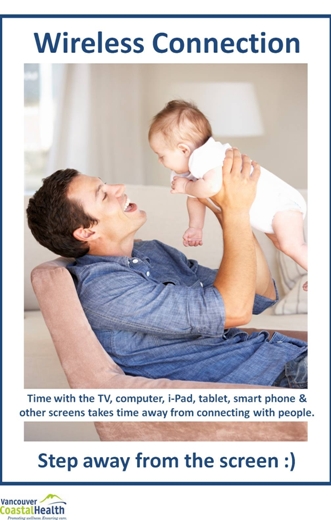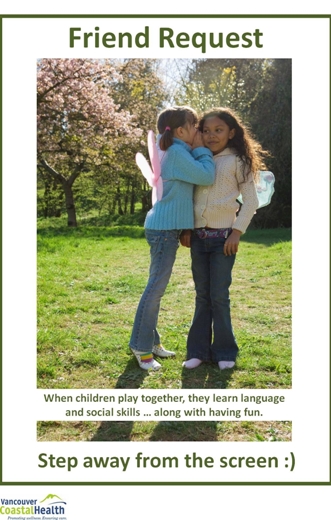Step away from the screen . . .
“Step away from the screen.” That’s the message from Speech Language Pathologists in Richmond as part of their month long awareness campaign aimed at encouraging parents to limit their children’s screen time and increase the time they spend enjoying other developmental activities.
It’s a world of wireless connections and technology. With hundreds of television channels, infinite internet viewing options and an abundance of websites and social media available to us at home or on the go, we are surrounded by a wealth of electronic opportunities. Media helps us give and get information and entertain ourselves.
But we can have too much of a good thing.
Over the past few years, speech language pathologists at the Richmond Public Health Speech and Language Program have noticed a concerning increase in preschoolers’ exposure to screen time – time with televisions, computers, tablets, cell phones and other devices. Why is this group of healthcare professionals so worried? Actually, there’s a number of reasons:
- Caregivers tell us they choose media for children as a tool for learning language. Some even tell us they are concerned when a child does not engage with media. Research actually shows that increased media exposure at younger ages has negative impacts on cognitive and language development. Children’s vocabulary and language growth is directly related to the time they spend talking with other people. Electronic devices are not replacements for this interaction.
- Caregivers are on their devices more often at home, in our waiting room and during speech and language therapy sessions, distracting them from interactions with their children. Media use by caregivers reduces the quality of adult-child interactions and can interfere with children’s vocabulary growth because caregivers and children are likely spending less time talking together.
- When caregivers report that their child has a high amount of media exposure, along with language and/or social delays, speech language pathologists and other professionals can have difficulty determining if the delays are due to screen time or other underlying difficulties requiring further assessment.
- When we talk to caregivers about reducing media exposure for our clients, we often see gains in language and social skills, along with family and community connections. Less screen time means more than just less screen time. It means more time exploring and learning while engaged in other activities and with other people.
What is best for media use and screen time? The Canadian Pediatric Society and American Academy of Pediatrics recommend:
- children over the age of 2 years and teenagers have less than 1 to 2 hours of total entertainment screen time per day.
- children under 2 should be kept away from screen time as completely as possible.
There are many other ways that children and adults can enjoy connecting with people and spending alone time with non-electronic activities. Read books, do crafts, cook, go for a walk, play at the park, enjoy a meal, sing, dance … just step away from the screen. 🙂



